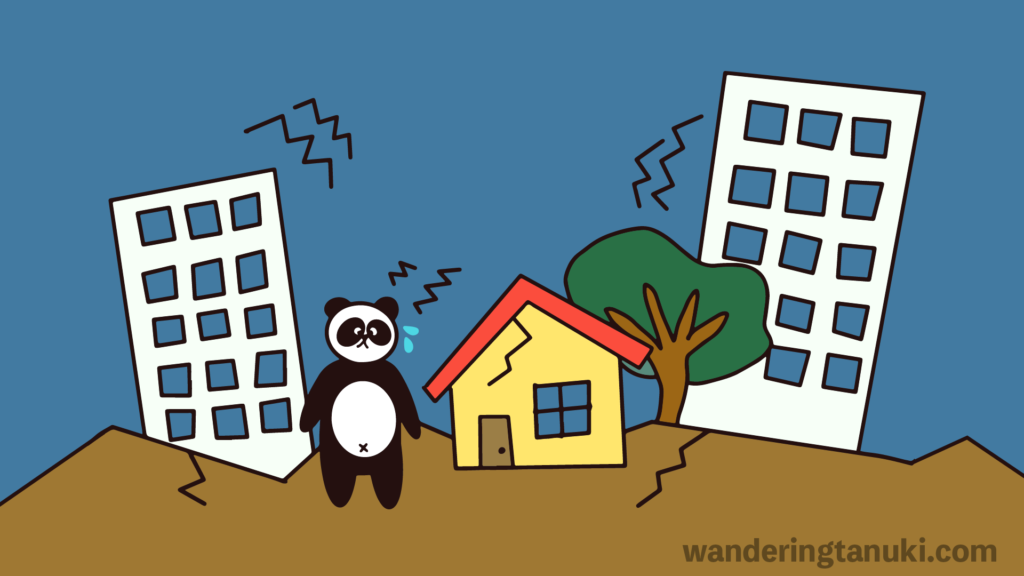Earthquakes and Tsunami in Japan: Tips to stay safe
If you’re traveling or planning to live in Japan, you’ll want to know how to stay safe from earthquakes and tsunamis. Compared to other natural disasters, earthquakes can’t really be predicted. The reason Japan has so many earthquakes is because it is located in the Pacific ring of fire. There are a total of 450 volcanoes in this “ring” and the vast majority of earthquakes on earth occur in this area.

What is an earthquake and tsunami:
First, let’s go over the definition of earthquakes and tsunamis.
Earthquakes are caused when tectonic plates (plates that make up the earth’s crust) suddenly slip. Tectonic plates on the earth’s surface are moving slowly but they can get stuck causing pressure between the plates.
Tsunamis are the result of earthquakes that happen under or near the ocean. The shaking causes huge waves to develop that can cause heavy damage to coastal areas.
How to stay safe during an Earthquake/Tsunami:

Here are some tips on how to stay safe the moment an earthquake happens.
– If you are indoors:
Open the doors and turn off the stove when you hear an earthquake alarm. Take cover under a sturdy table. If you can’t find a sturdy table, you can also go to a corner of the room where two walls meet. Try to stay clear of windows and large objects that might fall.
– If you are outdoors:
Go to an open area and stay clear of buildings, streetlights, windows, and anything that might fall. Make sure to stay in the same place until you’re sure the earthquake is over.
– If you are near the ocean:
For weak earthquakes they don’t usually cause tsunamis. However, it’s better to be overly cautious than too late. Some beaches will have alarms that will go off if there is a tsunami warning. If you hear a tsunami alarm, feel a strong earthquake, or notice the water level changing go to high ground by foot as soon as possible.
– If you’re driving:
Gradually stop the car and try to stay away from anything that looks like it could fall. Turn off your engine. Avoid being under bridges or overpasses. If possible, stay in an open area. In most cases, it is better to stay inside your car.
What you can do in advance of an Earthquake:
You can’t predict an earthquake but you can always be prepared! Here are 5 tips on things you can do to in advance:
1. If you live in Japan, it is useful to have an emergency backpack with essential items like flashlights, first aid kits, etc…. You can also keep a supply of food and water that won’t go bad in your house.
2. Keep your shoes near your bed when you sleep. After an earthquake there may be glass or broken debri on the ground.
3. Make sure to sleep in a place that doesn’t have huge bookshelves or T.V.’s that can fall on top of you. If it’s your own home, you can also secure these items to the walls so they are less likely to fall.
4. Always be aware of where you’re located and where you might be able to go if an earthquake happens. For example, if you’re at the beach you should go to high ground after a strong earthquake to be safe from a tsunami.
5. Be careful of aftershocks after large earthquakes. If there was a strong recent earthquake in the area you can expect smaller earthquakes in the coming weeks and months.
Japan-specific safety measures for Tsunami and Earthquakes:

Since Japan is prone to Earthquakes, there are many safety measures put into place.
– Earthquake/Tsunami alarms:
In Japan, there is an Earthquake Early Warning which notifies people up to one minute before an earthquake. This can give enough time to turn off the stove, open the door, and take cover.
Most phones in Japan will automatically send out this warning. Make sure to turn on emergency notifications. In addition, T.V. broadcast stations will announce this warning on live T.V. After the earthquake, they will also say whether there is a threat of a tsunami. Near beaches there are usually speakers that will sound an alarm if there is a threat of a tsunami.
– Earthquake resistant buildings:
Japan has some of the most earthquake resistant buildings in the world. With many high rises and a high population density, it’s important for structures to withstand earthquakes. With every major earthquake, Japan has been revising its building laws to make them safer. Some of these earthquake resistance technologies include making the building able to dampen the force of energy from the earthquake.
– Evacuation sites:
Because Japan has many natural disasters, there should be a designated evacuation area for each district. Make sure to know these in advance especially if you are living there. Temporary evacuation sites are usually nearby parks and for overnight evacuations they can be in school gymnasiums.
Major historic earthquakes in Japan:

1923 Great Kanto Earthquake
This earthquake was one of the most devastating earthquakes in Japanese history. It was around magnitude 8 and hit the Kanto region which included big cities like Tokyo and Yokohama. The casualties from this quake was around 100,000 – 150,000. The high casualties resulted from tsunamis, fires, as well as buildings that were not made to withstand such a strong quake.
1995 Great Hanshin Earthquake
The Great Hanshin Earthquake is another large quake that caused severe damage. It impacted the Hyogo prefecture of Japan and was magnitude 7. Although there were new earthquake resistant building requirements in the 1980’s, old buildings didn’t have to follow the building requirements. This caused widespread damage to offices, residential buildings, and even highways and subway systems.
2011 Tohoku Earthquake
A magnitude 9 earthquake hit the Pacific ocean near the Tohoku region which caused huge tsunamis and mass casualties. It also damaged a nuclear power plant, which became one of the biggest nuclear disasters since Chernobyl.
Earthquake/Tsunami Resources for Japan:
Website that shows the latest earthquakes in Japan
https://www.data.jma.go.jp/multi/quake/index.html?lang=en
Tokyo Disaster prevention Website (check your local area if outside Tokyo):
https://translation2.j-server.com/LUCTBOUSAI/ns/tl.cgi/https://www.bousai.metro.tokyo.lg.jp/index.html?SLANG=ja&TLANG=en&XMODE=0&XCHARSET=utf-8&XJSID=0
Very detailed disaster management pamphlet by government of Japan
http://www.bousai.go.jp/1info/pdf/saigaipamphlet_je.pdf
I hope that this article about earthquakes and tsunamis in Japan was helpful! If you’d like more articles on travelling japan be sure to check out Top 10 Ghibli Tourist Spots in Japan or 11 Japanese Shinto Gods and Shrines to Visit!
~ Tanuki





